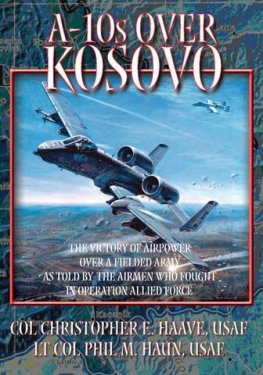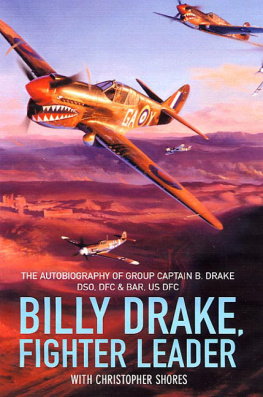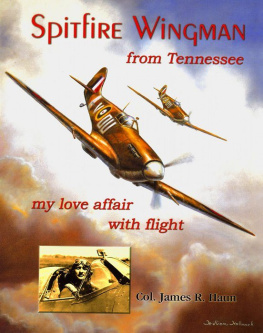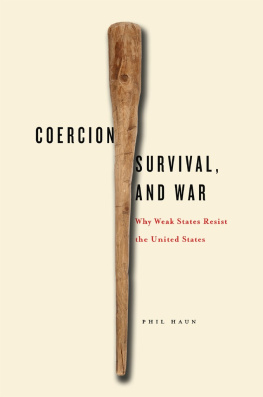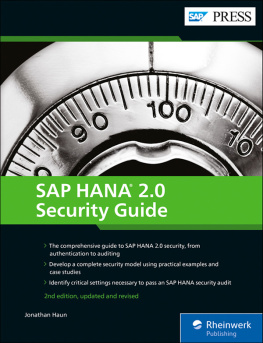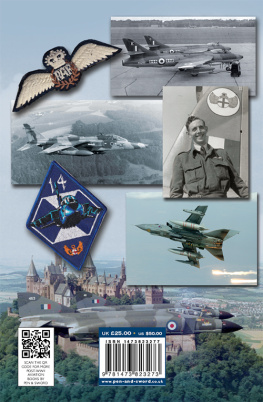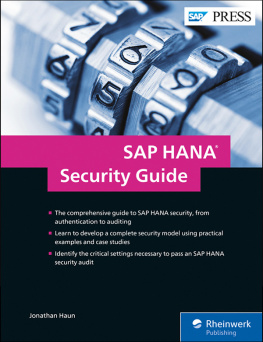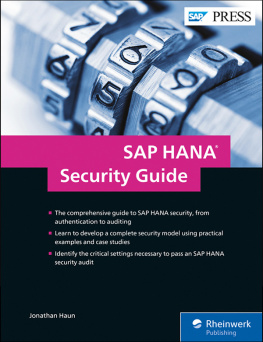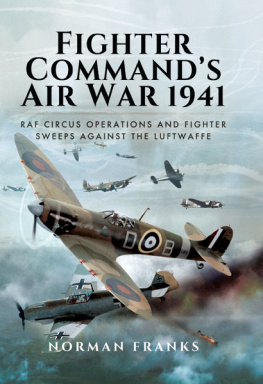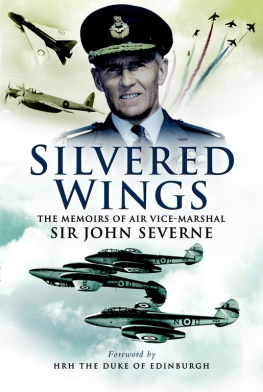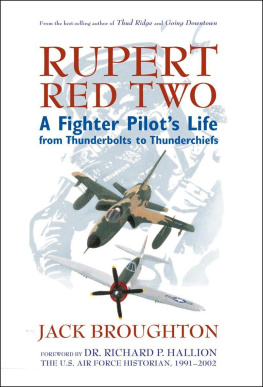A-10s OVER KOSOVO
The Victory of Airpower over a Fielded Army as Told by the Airmen Who Fought in Operation Allied Force
Edited by
CHRISTOPHER E. HAAVE, Colonel, USAF
and
PHIL M. HAUN, Lieutenant Colonel, USAF
We owe much of our combat success to many outstanding folks who were not present at either Aviano AB or Gioia del Colle AB. Those folks include families and friends who supported us from afar, leaders and commanders who placed faith in our abilities, fellow warriors who shared the danger in the air, dedicated professionals at home bases who provided the logistical lifeblood, and all the past and present members of the A-10 and Air Force communities who trained us right. All these loved ones and colleagues deserve the lions share of credit for the A-10 achievements during Allied Force.
In the spring of 1999, NATO engaged in a precedent-setting air campaign over Serbia and Kosovo known as Operation Allied Force (OAF). This event marked a milestone for airpower, as it was, arguably, the first time airpower alone was decisive in achieving victory in combat. By the end of the conflict, in June 1999, America and its allies had mounted a monumental effort to achieve the immediate goals of halting ethnic cleansing in Kosovo and providing for the return of hundreds of thousands of refugees. Ground forces, introduced following the end of the air campaign, have subsequently been employed to secure the peace.
Several books have already been written about OAF, though not as many as might have been expected given the implications for NATO and airpower that came out of that conflict. Those that have been written focus primarily on the strategic level, the events, diplomacy, and decisions by senior military and political leaders that led to the conflict and determined its conduct. This is not that kind of book. This is about the other end of the spectrum as told by those that flew and fought at the most basic level during the warthe A-10 pilots of the 40th Expeditionary Operations Group (EOG).
I was privileged to command the 52d Air Expeditionary Wing during OAF. The 40th EOG was one of four such groups in my wing. Its members job was to find and destroy fielded Serb forces in Kosovo and to provide combat search and rescue for downed allied aircrews. This is their story. They take you into the cockpit where you learn how the strategic policy was ultimately put into action.
After the war, one senior Air Force officer said, About 80 percent of the airpower effort was magnificent, but the other 20 percent was pretty ugly. Through the eyes of the 40th EOG, youll see the good, the bad, and the ugly. You will appreciate the enormous pressures placed on our fighter pilots as they strove to find and verify valid military targets, protect the civilian population against collateral damage, destroy fielded Serbian forces, and rescue downed airmen. Youll appreciate how well and how professionally they carried out their mission, and you will experience the frustration that comes from waging war within the inevitable restrictions placed by our leaders.
OAF was an unusual war in many ways. Indeed, due to allied political sensitivities, we didnt even call it a war for quite some time. Gen Wesley K. Clark, supreme allied commander in Europe termed it diplomacy by force until he retired. While victory was ultimately achieved, it was never declared. Nevertheless, for those who flew in it, OAF was war, and especially for the A-10 pilots it was tough, dangerous, and personal. Im honored to have led these outstanding warriors, and I support their effort to preserve their experiences in writing. There are important lessons here for all of us. This is their story, in their own wordsexciting, unvarnished, and on target.
SCOTT P. VAN CLEEF
Brigadier General, USAF
Commander
52d Air Expeditionary Wing
PROLOGUE
Lt Col Chris Kimos Haave
In May 1999, our 81st Expeditionary Fighter Squadron (EFS) was flying out of Gioia del Colle Air Base (AB), Italy, conducting around-the-clock combat operations in support of Operation Allied Force (OAF). In the midst of this, several pilots began talking about writing a book. Those of us who were airpower and military-history buffs noticed that the combat we were experiencing was far different from much of what we had studied. After Slobodan Milosevic capitulated and OAF ended in June, we took stock of what we had done and promised each other to write down our combat experiences and observations. A-10s over Kosovo is the fruit of that commitment.
Our initial vision for this book was to let each pilot tell an anecdote or two. Taken collectively, those stories would provide others with an idea of what an A-10 group had, or had not, accomplished. However, as we wrote and exchanged ideas, we decided that the book should focus primarily on the missions. Therefore, in the end, our book includes many personal accounts of our relocation and beddown, aircraft maintenance, and combat experiences; we tried to describe the tactical execution of those missions and the many activities that directly, or indirectly, supported them.
We have limited our focus to the contributions of the 40th Expeditionary Operations Group (EOG) comprised of personnel from the 81st EFS at Spangdahlem AB, Germany, and the 74th EFS from Pope Air Force Base, North Carolina. While we fondly mention some of the combat contributions of our fellow A-10 warriors in the 104th EOG who operated out of Trapani AB, Sicily, we do not tell their complete story.
The scope of A-10s over Kosovo is limited to the 40th EOGs participation in OAF. For simplicitys sake we use the Kosovo engagement zone (KEZ) to describe that area of Kosovo and southeastern Serbia where A-10 aircrews flew their portion of the air campaign against fielded Serbian forces. Additionally, Sandys (A-10 pilots qualified to lead combat search and rescue [CSAR] missions) were responsible to cover the entire OAF theater of operations. Covering that around-the-clock CSAR alert during the entire 78-day campaign required A-10 crews to spend as many hours on ground alert as actually flying.
This books objectives are to include firsthand accounts by those who participated and share the observations and conclusions seen from their tactical points of view. We humbly acknowledge that we did not thoroughly research the operational and strategic levels of the air campaign, nor did we investigate the many decisions up and down the chain of command that affected the missions and the rules of engagement (ROE). Also beyond our scope was a rigorous analysis of the international political-military discussions and decisions above the level we could directly observe. For these reasons, we have limited our focus to the expeditionary squadron and group levels. While the reader might occasionally sense some frustration in an authors personal account, we have collectively attempted to refrain from drawing conclusions about why we were ordered to conduct our operations in a particular manner. We do not feel qualified to comment on the appropriateness of particular courses of action (COA) and ROEs. However, since our firsthand tactical experience allowed us to observe the effect that those COAs and ROEs had on our missions, we are comfortable in sharing those observations with our readers and pointing out those areas we consider worthy of further investigation and improvement.
We have presented each contributors account, editing only for clarity, accuracy, and to avoid repeating each others stories. We found that letting each participant speak freely was the most legitimate way to tell the A-10 story. We have organized these stories to illustrate each chapters theme and have tried to retain their you-are-there quality.

